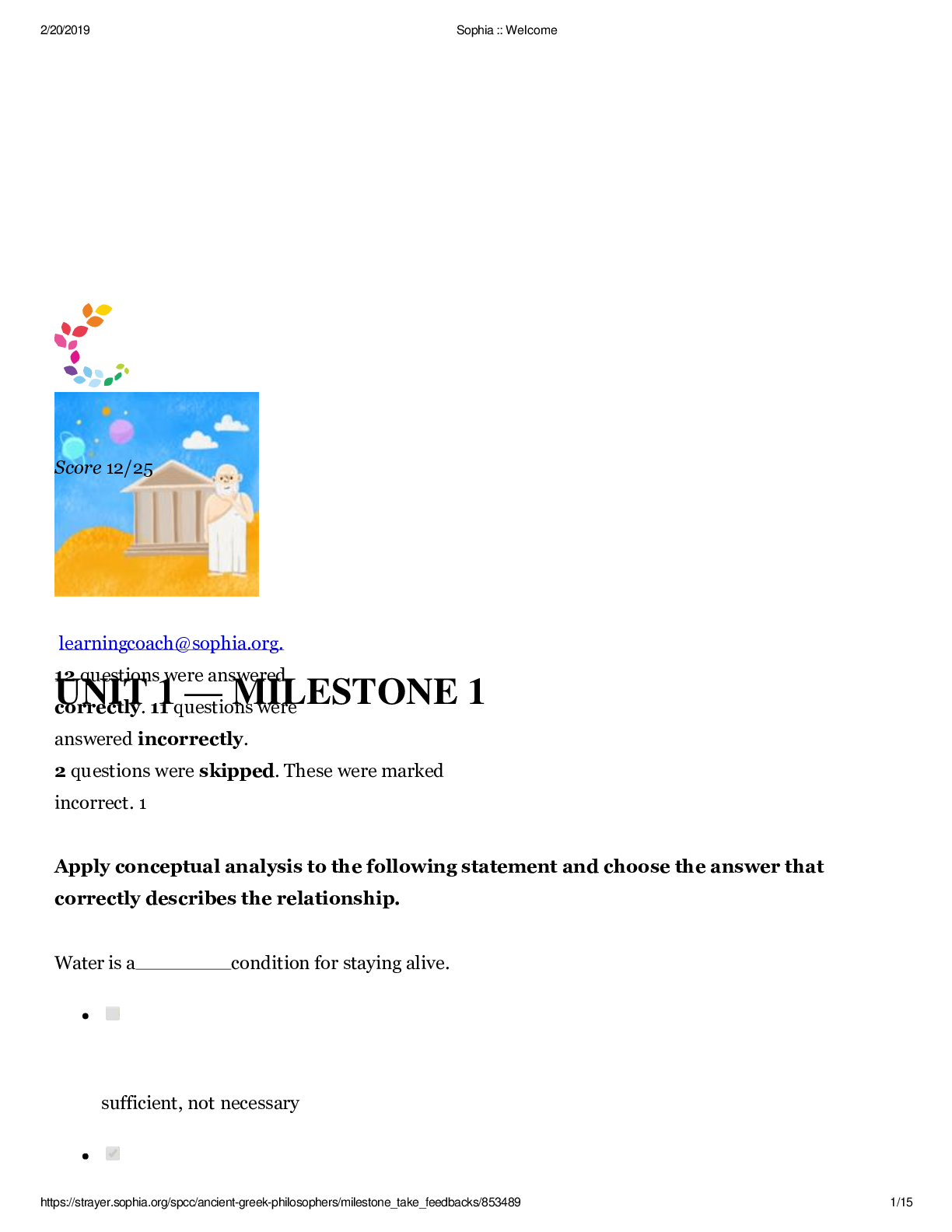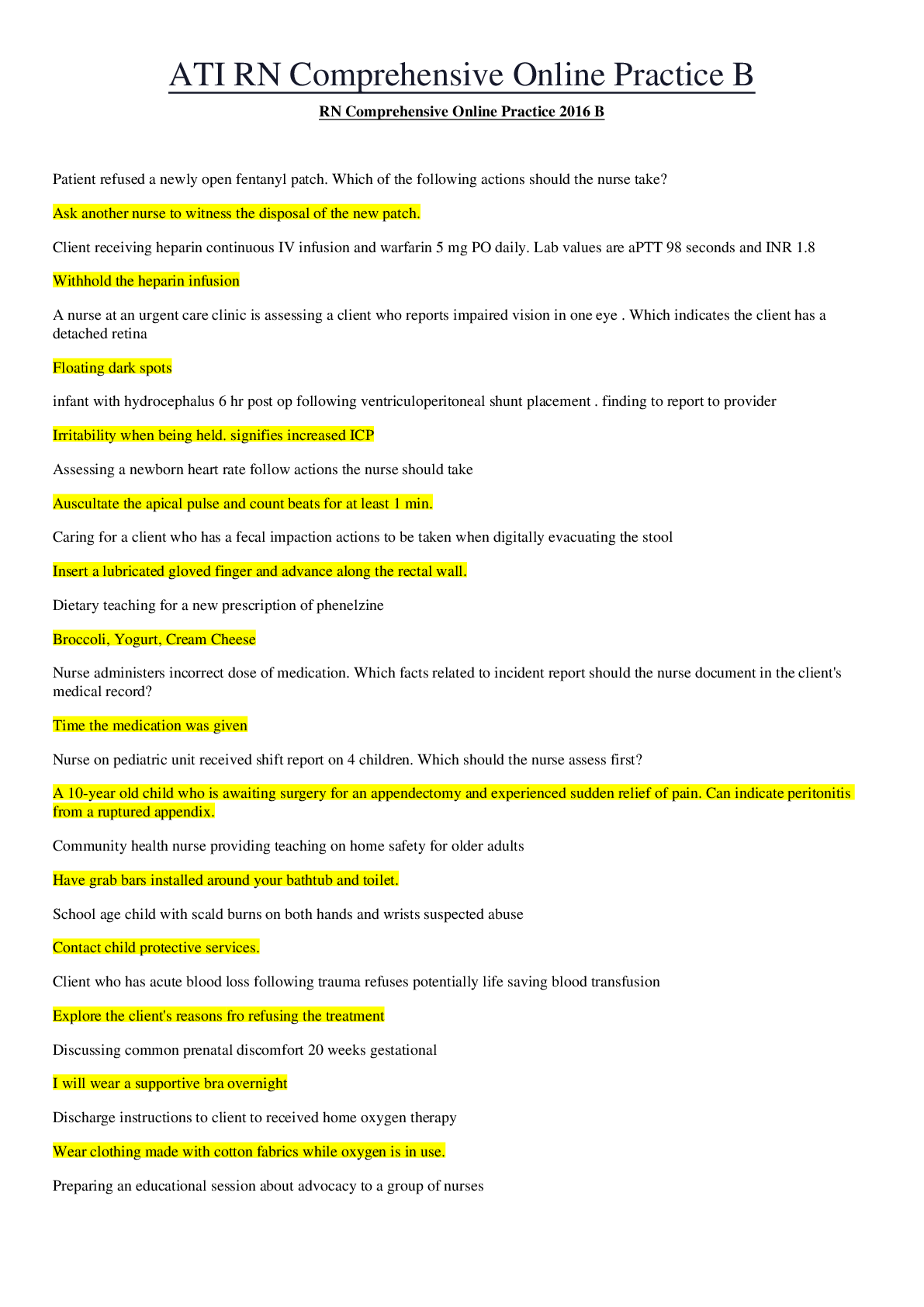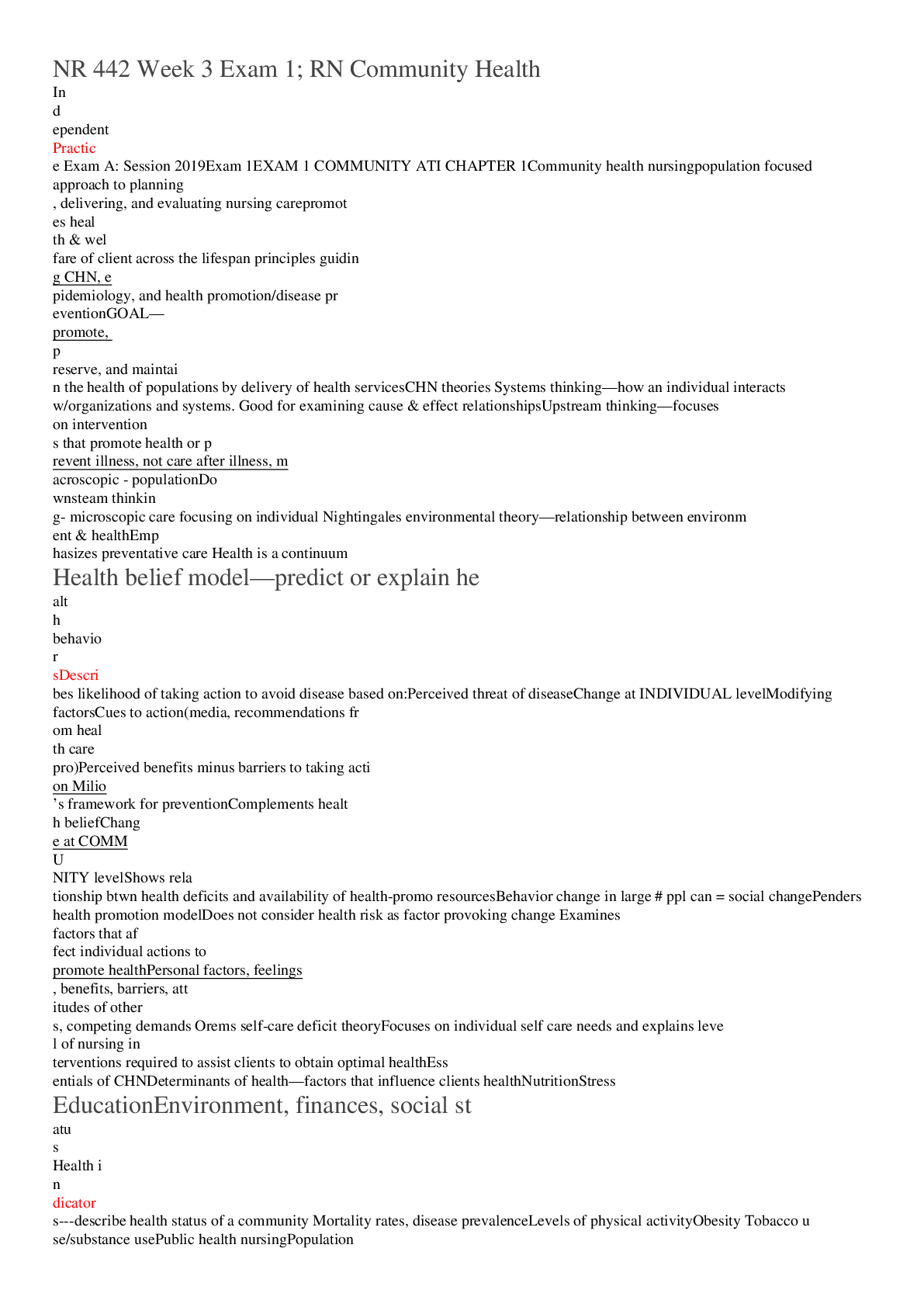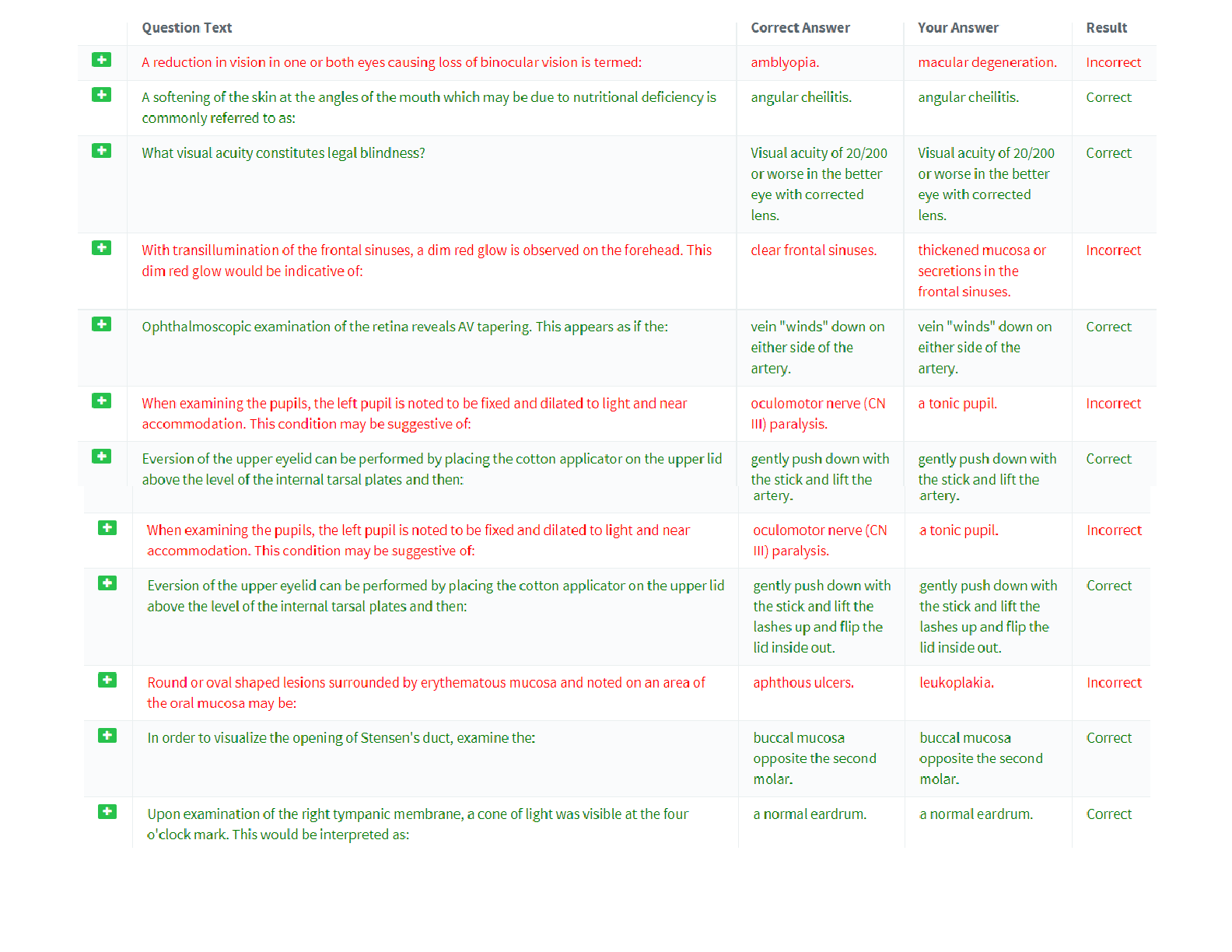Business > EXAM > NR 351 Week 3 Exam with answers - Wagner College (A grade) | NR351 Week 3 Exam with answers - A grad (All)
NR 351 Week 3 Exam with answers - Wagner College (A grade) | NR351 Week 3 Exam with answers - A grade
Document Content and Description Below
NR 351 Week 3 Exam with answers - Wagner College (A grade) NR 351 Exam 3 Chapter 20 Communication- PRIMARY aspect- can be verbal or nonverbal Encoder- person who starts message/communication... uses a ‘medium/channel’ Decoder- receiver of communication Gait- how people walk Electronic communication- depends on the policy of where you work; ex/ e-mail Four Levels of Communication • Intrapersonal- self talk, communication with one self; ex/ positivity • Interpersonal- occurs between 2 or more people with the goal to exchange messages • Negative interpersonal behavior: • Incivility, bullying (horizontal violence, eye rolling, negative communication) • Small group- nurses interact with 2 or more individuals; ex/ project groups • Organizational- individuals and groups within an organization communicate to achieve established goals; ex/ morbidity & mortality conferences (m&m’s) • Group dynamics- how individual group members relate to each other during the process of working toward group goals The Helping Relationship • Patients tend to sue more if this relationship isn’t formed • The nurse is the helper and the patient is the person being helped • 3 phases of helping relationship: • Orientation phase • Establish tone and guidelines for the relationship • Provide the patient with orientation to the healthcare system • Working phase- longest phase • Work together to meet the patients needs • Provide teaching, counseling and assistance to achieve each goal • Termination phase • Make suggestions for future, if necessary • Assist patient transferring from one agency to another; or even going home • Help start a helping relationship with another nurse, if needed **Remember ISBARQ patient hand-off technique Interviewing techniques- from assessment • Be assertive, not aggressive • Confident, calm, asking for help when necessary • Ability to share effectively and admit mistakes when made Chapter 21 Aims of Teaching and Counseling: • Maintaining and promoting health- hygiene, nutrition, exercise • Preventing illness- first aid, safety, immunizations • Restoring health- self-care practices the patient and family learn • Facilitating coping- stress management, resources, referrals, counseling TEACHing acronym Tune into the patient Edit patient information Act on every teaching moment Clarify often Honor the patient as partner in the education process ASK ME 3 Questions • What is my main problem? • What do I need to do? • Why is it important for me to do this? 3 Learning Domains • Cognitive- new knowledge • Lecture, discussion, audiovisual, printed materials • Psychomotor- learning a physical skill • Demonstration, audiovisual • Affective- changing attitudes, values and feelings • Role modeling, discussion, role playing COPE model- creativity, optimism, planning, expert information Assessment of Patient Learning • Knowledge, skills, attitudes (KSA)- needed to be independent in order to manage their healthcare • Readiness to learn- willingness to engage in the teaching-learning process • Ability to learn • Learning strengths Sources of Information • Primary- patient • Secondary- medical records, patient family Types of Counseling • Short-term- situational crisis- when a patient faces an event or situation that causes a disruption in their life • Long-term- developmental crisis- when a person is going through a developmental stage or passage; ex/menopause • Motivational learning- evidence-based approach that involves discussing feelings and incentives Chapter 22 Types of Power • Explicit- power by virtue of position; ex/ president • Implied- power due to other factors, such as personality; ex/ student class Leadership: • Qualities- charismatic, confident, flexible, knowledagble • Skills- commitment to excellence, problem-solving skills, respectfulness • Styles- autocratic, democratic, laissez-faire (whatever, non-directive), transactional (give/get mindset) Role of Nurse Manager- planning, organizing, staffing, directing, controlling Clinical Nurse Leader Role- created in 2003 as a leadership role Management Structures • Centralized- senior managers generally make decisions with little input from the group • Decentralized- decisions are made by those who are most knowledgeable about issues; nurses are involved in decisions with patient care Lewin’s Theory of Change • Unfreezing- the need for change is recognized • Moving- change is initiated after a careful process of planning • Refreezing- change becomes operational -- - - - - - - - - - - - - - - - - - - - - -- - - - - - Chapter 16 What is Confidential? all info about patients written o paper, spoken aloud or saved on computer patients have the right to save and copy their health record; update health record; request restriction; choose how to receive health information Verbal orders- only over phone and during emergencies Personal Health Records • Standalone personal health record: patients fill in info from their own records; info is stored on patients computer or internet • Tethered/connected personal health record: linked to a specific health care organization’s electronic health record system or to a health plan’s information system Methods of Documentation • source-oriented records- paper format • problem-oriented medical records- organized around patient problems • PIE charting (problem, intervention, evaluation) • Focus charting- patient and patient concerns • Charting by exception- shorthand; only significant findings • Case management model- patient with few needs; cost-effective • Computerized documentation/ EHR’s Requirements for Home Health Care • patient is homebound and still needs skilled nursing care • rehab potential is good (or patient is dying) • patients status isn’t stabilized • patient is making progress in expected outcomes of care Four Components of RAI (resident assessment tool) • minimum data set • triggers • resident assessment protocols • utilization guidelines - Benefits: residents respond to individualized care; staff communication becomes more effective; documentation becomes clearer [Show More]
Last updated: 2 years ago
Preview 1 out of 15 pages
.png)
Buy this document to get the full access instantly
Instant Download Access after purchase
Buy NowInstant download
We Accept:

Reviews( 0 )
$11.50
Can't find what you want? Try our AI powered Search
Document information
Connected school, study & course
About the document
Uploaded On
Jan 18, 2021
Number of pages
15
Written in
Additional information
This document has been written for:
Uploaded
Jan 18, 2021
Downloads
0
Views
92
.png)








 – University of the People.png)














.png)
.png)

